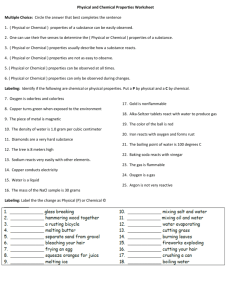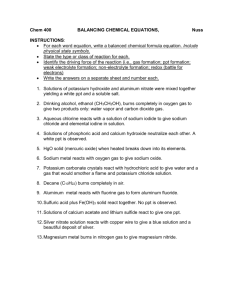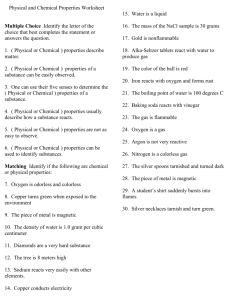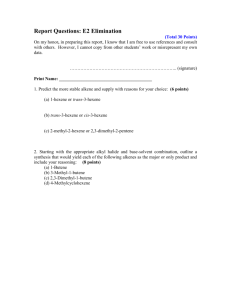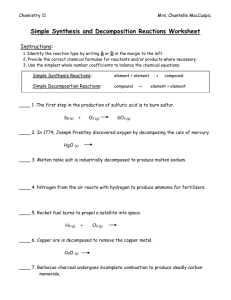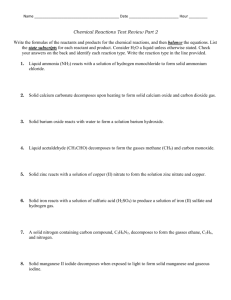File
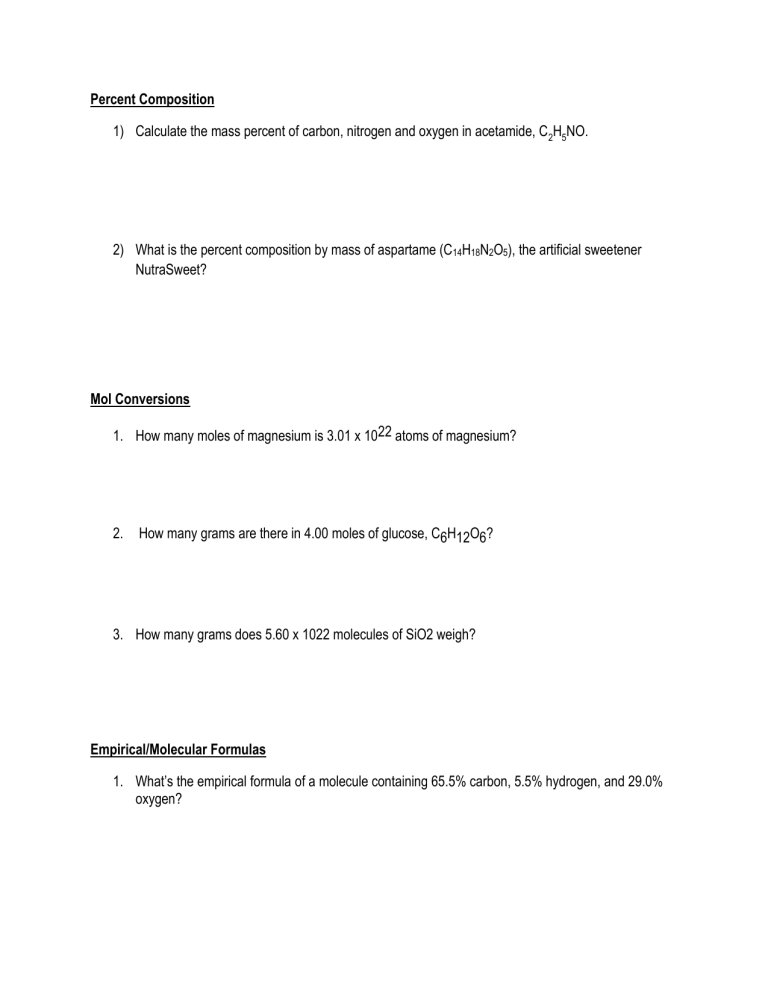
Percent Composition
1) Calculate the mass percent of carbon, nitrogen and oxygen in acetamide, C
2
H
5
NO.
2) What is the percent composition by mass of aspartame (C
14
H
18
N
2
O
5
), the artificial sweetener
NutraSweet?
Mol Conversions
1.
How many moles of magnesium is 3.01 x 1022 atoms of magnesium?
2.
How many grams are there in 4.00 moles of glucose, C6H12O6?
3.
How many grams does 5.60 x 1022 molecules of SiO2 weigh?
Empirical/Molecular Formulas
1.
What’s the empirical formula of a molecule containing 65.5% carbon, 5.5% hydrogen, and 29.0% oxygen?
2.
If the molar mass of the compound in problem 1 is 110 grams/mole, what’s the molecular formula?
3.
What’s the empirical formula of a molecule containing 18.7% lithium, 16.3% carbon, and 65.0% oxygen?
4.
If the molar mass of the compound in problem 3 is 73.8 grams/mole, what’s the molecular formula?
5.
A 50.51 g sample of a compound made from phosphorus and chlorine is decomposed. Analysis of the products showed that 11.39 g of phosphorus atoms were produced. What is the empirical
formula of the compound?
Chemical Equations
When a chemical reaction occurs it must obey the Law ______________________--matter is neither
created nor destroyed in an ordinary chemical reaction.
___Zn + ___HCl ---> ___ZnCl
2
+ ___H
2
Li + HOH ---> LiOH + H
2
___Sb + ___O
2
---> ___Sb
2
O
Pb(NO
3
)
2
+ Na
2
CrO
4
PbCrO
4
+ NaNO
3
3
Write out the equation and balance it:
1.
iron (III) oxide plus carbon when heated yields iron and carbon monoxide
2.
nickel plus copper (II) sulfate yields nickel sulfate plus copper
3.
aluminum plus silver nitrate yields aluminum nitrate plus silver
4.
sodium chromate plus silver nitrate yields sodium nitrate plus silver chromate
Chemical Reactions: Classify each of the following reactions as composition, decomposition, single
replacement or double replacement. Make sure they are balanced!!!
MgCl
2
+ 2 AgNO
3
---> Mg(NO
3
)
2
+ 2 AgCl 2 Al
2
O
3
---> 4 Al + 3 O
2
H
2
O + SO
2
---> H
2
SO
3
Mg + 2 AgNO
3
---> Mg(NO
3
)
2
+ 2 Ag
H
2
CO
3
---> H
2
O + CO
2
Cl
2
+ CaI
2
---> CaCl
2
+ I
2
Classify each of the following reactions as acid-base, combustion, precipitation reactions.
3 H
2
SO
4
+ 2 Ga(OH)
3
6 H
2
O + 1 Ga
2
(SO
4
)
3
1 C
4
H
8
+ 6 O
2
4 CO
2
+ 4 H
2
O
BaCl
2
(aq) + Na
2
SO
4
(aq)- BaSO
4
(s) + 2NaCl(aq)
CHEMISTRY WORKSHEET NAME _________________________
INTRODUCING EQUATIONS HOUR DATE _______________
When we started this year we memorized chemical symbols that are used to represent ___
Then we spent several weeks learning to write formulas that are used to represent . Now we are going to learn to write equations that represent .
Chemical reactions produce new substances with new properties. The starting materials in a chemical reaction are called reactants while the materials that are formed are called products. When we write an equation we put an arrow in the middle between the reactants and the products; this arrow is read as yields.
Example:
Example:
Ba(NO
3
)
2
+ H
2
SO
4
---> BaSO
The names of the reactants are: _________________________________
_________________________________
The names of the products are: _________________________________
__________________________________
2 Al + 3 S ---> Al
2
S
3
4
+ 2 HNO
3
The names of the reactants are: __________________________________
The name of the product is:
_________________________________
______________________
In order to help students recognize patterns and be able to predict the products of chemical reactions we classify most chemical reactions as one of four common types of reaction--composition, decomposition, single replacement and double replacement.
In composition reactions elements combine to form a compound; or, in some cases, simple compounds combine to form a more complex compound.
EXAMPLES: 2 Na + S ---> Na
2
S
The names of the reactants are :
__________________________________
The name of the product is:
_____________________________
______________________________
H
2
O + SO
2
---> H
2
SO
3
The names of the reactants are :
The name of the product is:
_____________________________
_____________________________
In decomposition reactions compounds are broken apart to form elements; or, in some cases, complex compounds are decomposed to form simpler compounds.
EXAMPLES: 2 Al
2
O
3
---> 4 Al + 3 O
The name of the reactant is:
2
____________________________
The names of the products are: ____________________________
H
2
CO
3
---> H
2
O + CO
2
The name of the reactant is:
____________________________
____________________________
The names of the products are: ____________________________
____________________________
In single replacement reactions one element takes the place of a second element in a compound.
EXAMPLES: Mg + 2 AgNO
3
---> Mg(NO
3
)
2
+ 2 Ag
The names of the reactants are: _________________________________
___________________________________
The names of the products are: __________________________________
___________________________________
Which element was replaced?
Which element did the replacing?
Cl
2
+ CaI
2
---> CaCl
2
+ I
2
______________________________
______________________________
The names of the reactants are: ___________________________
_____________________________________
The names of the products are: ______________________________
Which element was replaced?
Which element did the replacing?
_____________________________________
_____________________________________
_____________________________________
In double replacement reactions two compounds react with each other--the positive ion of one compound combines with the negative ion of the second compound and vice versa.
Examples: MgCl
2
+ 2 AgNO
3
---> Mg(NO
3
)
2
+ 2 AgCl
The names of the reactants are: ___________________________
______________________________________
The names of the products are: ___________________________
______________________________________
Al(OH)
3
+ 3 HNO
3
---> Al(NO
3
)
3
+ 3 HOH
The names of the reactants are: ______________________________________
_________________________
The names of the products are: __________________________
______________________________________
Classify each of the following reactions as composition, decomposition, single replacement or double replacement.
1. Ba + Cl
2
---> BaCl
2
2. Zn + Cu(NO
3
)
2
---> Zn(NO
3
)
2
+ Cu
3. 2 Ga + 3 S ---> Ga
2
S
3
4. 2 NaOH + H
2
SO
4
---> Na
2
SO
4
+ 2 HOH
5. 2 K + 2 HOH ---> 2 KOH + H
2
6. 2 H
2
O ---> 2 H
2
+ O
2
7. 4 Li + O
2
---> 2 Li
2
O
8. BaO
2
+ H
2
SO
4
---> BaSO
4
+ H
2
O
2
9. Br
2
+ 2 NaI ---> 2 NaBr + I
2
10. CaCO
3
---> CaO + CO
2
(You will notice that several elements had a subscript 2 after them in the above equations. There are seven elements that exist as diatomic molecules when they are not in compounds. The seven elements are: hydrogen-H
2
, nitrogen-N
2
, oxygen-O
2
, fluorine-F
2
, chlorine-Cl
2
, bromine-Br
2
, and iodine-I
2
. These elements DO NOT have to be in twos in compounds--you continue to write the formulas for compounds just as you always have. They are in twos only when they are elemental.)
When a chemical reaction occurs it must obey the Law of Conservation of Matter--matter is neither
created nor destroyed in an ordinary chemical reaction. That means that for any element in the reaction there must be the same number of atoms on each side of the arrow. These atoms are in different combinations or groupings but you must not create nor destroy atoms. (It is very much like shuffling and dealing cards--you don't create or destroy cards, you just change the combinations.) A balanced chemical equation obeys the law of conservation of matter--the equation is not true and has
no meaning until it is balanced. We balance equations by inserting coefficients in front of the formulas--DO NOT CHANGE THE FORMULAS! (We have spent weeks learning to write correct formulas--we don't abandon all of that when we start to balance equations.)
EXAMPLES: Zn + HCl ---> ZnCl
2
+ H
2
----not balanced
Zn + 2 HCl ---> ZnCl
2
+ H
2
----balanced
Sb + O
2
---> Sb
4 Sb + 3 O
2
2
O
3
---> 2 Sb
----not balanced
2
O
3
----balanced
Classify each of the following reactions as composition, decomposition, single replacement or double replacement. Then balance each of the equations.
(Note: when you have polyatomic ions they may usually be balanced as a group; only when the ion is broken apart do you have to look at individual atoms within the group.)
1. K + S ---> K
2
S
2. Sb + Cl
2
---> SbCl
3
3. Cd + AgNO
3
---> Cd(NO
3
)
2
+ Ag
4. Al
2
O
3
---> Al + O
2
5. Al + F
2
---> AlF
3
6. Mg(OH)
2
+ HNO
3
---> Mg(NO
3
)
2
+ HOH
7. Fe + O
2
---> Fe
2
O
3
8 . Li + HOH ---> LiOH + H
2
9. MgCO
3
---> MgO + CO
2
10. CsClO
3
---> CsCl + O
2
11. HgO ---> Hg + O
2
12. Hg
2
(NO
3
)
2
+ NaCl ---> Hg
2
Cl
2
+ NaNO
3
13. Ga + HCl ---> GaCl
3
+ H
2
14. Ca(OH)
2
+ (NH
4
)
2
C
2
O
4
---> CaC
2
O
4
+ NH
4
OH
15. Pb(C
2
H
3
O
2
)
2
+ K
2
SO
4
---> PbSO
4
+ _____ KC
2
H
3
O
2
Chemistry Equations – Worksheet #1 Name _____________________________
We have learned symbols for elements and to write formulas for compounds. Now we must learn to write equations to represent chemical reactions. Chemical reactions obey the Law of
Conservation of Matter: matter is neither created nor destroyed during a chemical reaction. This means that in any chemical reaction we simply rearrange the atoms much like shuffling of cards rearranges the cards but does not change the whole number of each type of card present. Because reactions obey the Law of Conservation of Matter, equations must be balanced: that is, the total number of atoms of each element must be the same on each side of the equation. You do not have a
chemical equation until it is balanced. Balancing is done by inserting coefficients for the terms in the equation; you never balance an equation by changing subscripts..
Many chemical reactions fit into one of four general classes: composition (or synthesis), decomposition (or analysis), single replacement (or simple replacement), and double replacement (or metathetical). If composition, elements combine to make a compound, while in decomposition; a compound is broken apart into its elements or simpler compounds. In single replacement, one element takes the place of another element in a compound, while in double displacement; the elements in two compounds switch partners with each other. Examples of the four types are:
Composition: 2Al + 3S Al
2
S
3
2H
2
O 2H
2
+ O
2
or H
2
CO
3
H
2
O + CO
2
Decomposition:
Single Replacement: Zn + 2AgNO
3
Zn(NO
3
)
2
+ 2Ag or Cl
2
+ 2NaBr 2NaCl + Br
2
Double Replacement: Pb(NO
3
)
2
+ Na
2
So
4
PbSO
4
+ 2NaNO
3
Balance the following by inserting the appropriate coefficient for each term. Also write the type of reaction in the blank to the left.
__________________________ 1. Mg + O
2
MgO
__________________________ 2.
__________________________ 3.
AgNO
3
+ BaCl
2
N
2
+ H
2
NH
3
AgCl + Ba(NO
3
)
2
__________________________ 4.
__________________________ 5.
Al + O
2
Al
2
O
3
Na + HOH NaOH + H
2
__________________________ 6.
__________________________ 7.
NaOH + H
2
SO
4
Na
2
SO
4
+ HOH
Al
2
(SO
4
)
3
+ Ca(OH)
2
Al(OH)
3
+ CaSO
4
__________________________ 8. HgO
Hg + O
2
Ba(OH)
2
+ HNO
3
Ba(NO
3
)
2
+ HOH __________________________ 9.
__________________________ 10. P
4
+ O
2
P
4
O
10
__________________________ 11. Al + CuSO
4
Al
2
(SO
4
)
3
+ Cu
__________________________ 12. Cl
2
+ NaI NaCl + I
2
__________________________ 13. Ba(OH)
2
+ HNO
3
Ba(NO
3
)
2
+ HOH
__________________________ 14. Ca(C
2
H
3
O
2
)
2
+ K
2
C
2
O
4
CaC
2
O
4
+ KC
2
H
3
O
2
__________________________ 15. NaClO
3
NaCl + O
2
Chemistry Equations – Worksheet #2 Name _____________________________
Chemical reactions always obey the Law of Conservation of Matter. Equations represent chemical reactions, but the following equations are not yet complete – they must be balanced before
they are truly equations. Once you insert the correct coefficients the equations are balanced and obey the Law of Conservation of Matter and then they describe chemical reactions. You may only use coefficients to balance the equations; you never change the subscripts, which are needed to give the
correct formulas.
The materials on the left of the equations are called reactants; the materials on the right side of the equation are called products. The arrow in the equations is read as yields. Notice that many of the equations involve the seven elements that exist as diatomic molecules when they are pure elements:
H
2
, N
2
, O
2
, F
2
, Cl
2
Br
2
, and I
2
. They do not exist in multiples of two in compounds – only when alone.
Insert coefficients to balance the following equations and classify the reactions in terms of type.
__________________________ 1.
__________________________ 2.
__________________________ 3.
__________________________ 4.
__________________________ 5.
__________________________ 6.
__________________________ 7.
__________________________ 8.
__________________________ 9.
AgNO
3
+ ZnCl
2
AgCl + Zn(NO
3
)
2
FeCl
3
+ NaOH Fe(OH)
3
+ NaCl
Al + H
2
SO
4
Al
2
(SO
4
)
3
+ H
2
P
4
+ O
2
P
4
O
6
K + HOH KOH + H
2
Ba(C
2
H
3
O
2
)
2
+ (NH
4
)
2
SO
4
BaSO
4
+ NH
4
C
2
H
3
O
2
Zn + HCl ZnCl
2
+ H
2
Sb + O
2
Sb
2
O
5
KClO
3
KCl + O
2
__________________________ 10. Pb(NO
3
)
2
+ Na
2
CrO
4
PbCrO
__________________________ 11. Fe
2
O
3
+ C
Fe + CO
2
4
+ NaNO
3
__________________________ 12. H
2
+ O
2
H
2
O
__________________________ 13. NaOH + H
2
SO
4
Na
2
SO
4
+ HOH
__________________________ 14. SO
2
+ O
2
SO
3
__________________________ 15. Al
2
O
3
DC
Al + O
2
__________________________ 16. Fe(ClO
3
)
3
+ NaSCN Fe(SCN)
3
+ NaClO
3
__________________________ 17.
__________________________ 20.
CaCO
3
CaO + CO
2
__________________________ 18. KOH + H
3
PO
4
K
2
HPO
4
+ HOH
__________________________ 19. H
2
O
2
H
2
O + O
2
CaCO
3
+ HCl CaCl
2
+ H
2
O + CO
2
Classroom Worksheet
______________________
Name
Vocabulary and Equations
Answer the following questions based upon your notes or upon the information given in the paragraphs found at the top of the equations writing sheets. It is important to be extremely familiar with the terms and information that follow in order to successfully write correct chemical equations.
1.
Chemical symbols represent _____________________________.
2.
Chemical formulas represent _____________________________.
3.
The charges that you use to help you write the correct formulas are called
__________________________.
4.
The small numbers that you insert when you write formulas are called
_____________________________.
5.
The total charge on any compound is _____________________.
6.
Define “polyatomic ions”, that is, tell what they are and how they behave.
__________________________________________________________________________________
__________________________________________________________________________________
________
7.
Why can’t polyatomic ions ever stand-alone?
_______________________________________________.
8.
What is true of the oxidation number of all metal ions?
________________________________________.
9.
Positive ions are called ____________________________.
10.
Negative ions are called _____________________________.
11.
Compounds that have names that end with the suffix “-ide” are _____________________________.
12.
Give the seven common metals that form ions with two different charges and given the two charges of each metal:____________________________________________________________________________
__________________________________________________________________________________
_________
13.
What ion is common to all acids? ________________________________
14.
Binary acids have names that start with the prefix “_________” and end with the suffix
“____________”
15.
Ternary acids containing an “-ate” polyatomic ion are named with the suffix
“____________________”.
16.
Ternary acids containing a “per—ate” polyatomic ion are named with the suffix
“___________________”.
17.
Ternary acids containing an “-ite” polyatomic ion are named with the suffix
“_____________________”.
18.
Ternary acids containing a “hypo—ite” polyatomic ion are named “_____________---
_____________”.
19.
Give the names and formulas for the six common acids referred to below: a. stomach acid or muriatic acid
_______________
_______________________________ b. battery acid
_______________
_______________________________ c. the acid in vinegar
_______________ e. the acid flavoring in colas
_______________
_______________________________ d. the acid in carbonated beverages _______________________________
_______________
_______________________________ f. the acid that turns protein yellow _______________________________
_______________
1.
Write the formulas for:
Perchloric acid, chloric acid, chlorous acid, hypochlorous acid, and hydrochloric acid
____________ ____________ ____________ ____________ ____________
2.
Chemical equations represent
_________________________________________________________.
3.
The starting materials in an equation are called the
_________________________________________.
4.
The arrow in an equation is read as ______________________________.
5.
The ending materials in an equation are called the ______________________________.
6.
The numbers we insert to balance an equation are called the
________________________________.
7.
A triangle over the arrow in an equation means __________________________________.
8.
DC over the arrow in an equation means _______________________________.
9.
A word that means to decompose a compound by electricity is
_______________________________.
10.
The word molten means _________________________________________________.
11.
We must balance equations because “matter is neither created nor destroyed in an ordinary chemical reaction”. This statement is known as the
__________________________________________________.
12.
Write formulas for the molecules of the seven elements that exist in diatomic molecules:
__________________________________________________________________________________
___.
13.
Name the four general types of chemical reactions:
__________________________________________________________________________________
___.
14.
A metathetical reaction is another name for a _________________________________________ reaction.
15.
An insoluble compound formed during a chemical reaction is called a
____________________________.
16.
When carbonic acid forms as a product it decomposes to give
__________________________________.
17.
Burning means chemical combination with ________________ so you must add ___________ on the left.
18.
Another word that means burning is _____________________________________.
19.
Our common fuels are called ________________________ and contain the elements ______ and
______.
20.
The complete combustion of a hydrocarbon produces energy plus _______________ and
______________.
21.
The three steps involved in writing chemical equations are:
1.
__________________________________________________________________________________
_.
2.
__________________________________________________________________________________
_.
1.
______________________________________________________________________________
____.
Chemistry Equations – Worksheet #3 Name _____________________________
On the previous worksheets you were given the skeleton equations and simply had to balance them by inserting the correct coefficients. On this page you are given word equations, so for each reaction you must:
1.
Write a skeleton equation containing all of the correct formulas.
2.
Balance the equation by inserting the appropriate coefficients.
Remember to use H
2
, N
2
, O
2
, F
2
, Cl
2
, Br
2
, and I
2
when these elements are not in compounds. Put a triangle over the arrow for heat and DC for electrolysis.
1.
When you are writing the formulas simply think of all of the rules you have learned for formula writing and don’t worry about the overall equation. When writing the formulas for the products, be sure to just look at the word equation – not the formulas of the compounds on the left of the equation. DO NOT DRAG SUBSCRIPTS FROM THE LEFT TO THE RIGHT.
2.
After you have all of the correct formulas, insert the coefficients to balance the equation.
USE A SEPARATE SHEET OF PAPER TO WRITE EQUATIONS FOR THE FOLLOWING REACTIONS. ALSO
INDICATE THE TYPE OF REACTION FOR EACH REACTION.
5.
magnesium plus sulfur yields magnesium sulfide
6.
barium plus oxygen yields barium oxide
7.
aluminum plus chlorine yields aluminum chloride
8.
zinc plus hydrochloric acid yields zinc chloride and hydrogen
9.
sodium hydroxide plus sulfuric acid yields sodium sulfate plus water. (Write the water HOH.)
10.
potassium chlorate is heated and yields potassium chloride and oxygen
11.
lithium plus iodine yields lithium iodide
12.
nickel plus copper (II) sulfate yields nickel sulfate plus copper
13.
aluminum plus silver nitrate yields aluminum nitrate plus silver
14.
calcium carbonate plus hydrochloric acid yields calcium chloride, water (H
2
O), and carbon dioxide
15.
calcium hydroxide plus acetic acid yields calcium acetate and water (HOH)
16.
aluminum plus sulfuric acid yields aluminum sulfate plus hydrogen
17.
barium hydroxide plus nitric acid yields barium nitrate plus water (HOH)
18.
magnesium hydroxide plus sulfurous acid yields magnesium sulfite plus water (HOH)
19.
sodium plus water (HOH) yields sodium hydroxide plus hydrogen
20.
iron (III) oxide plus carbon when heated yields iron and carbon monoxide
21.
copper plus silver chlorate yields copper (II) chlorate and silver
22.
aluminum oxide is decomposed by electricity yielding aluminum and oxygen
23.
hydrogen peroxide is exposed to uv light and decomposes to water and oxygen
24.
methane burns (reacts with oxygen) giving carbon dioxide and water
Note: When you add an active metal to water or when you react an acid with a base and produce water it makes it easier to balance the equation if you write water as HOH and treat it as hydrogen hydroxide when you balance it. In any other reaction it is easier to write H
2
O and count the H’s and O’s separately.
Chemistry Equations – Worksheet #4 Name _____________________________
This page contains twenty word equations to give you practice writing balanced chemical equations.
After you have the total reaction (that means that the word equation tells you both the reactants and the products) remember that it is a two-step process to write the balanced equation for the reaction:
1.
Write the skeleton equation containing all of the correct formulas; you cannot start to balance
until all of the formulas are correct.
2.
balance the equation by inserting the correct coefficients.
USE A SEPARATE SHEET OF PAPER TO WRITE EQUATIONS FOR THE FOLLOWING REACTIONS. ALSO
INDICATE THE TYPE OF REACTION FOR EACH REACTION.
25.
silver nitrate plus iron (III) chloride yields silver chloride and iron (III) nitrate
26.
magnesium plus acetic acid yields magnesium acetate and hydrogen
27.
potassium chloride undergoes electrolysis yielding potassium and chlorine
28.
sulfur dioxide plus water (H
2
O) yields sulfurous acid
29.
heating calcium hydroxide yields calcium oxide and water (H
2
O)
30.
iron (II) sulfide plus hydrochloric acid yields iron (II) chloride and hydrogen sulfide
31.
calcium plus water (HOH) yields calcium hydroxide and hydrogen
32.
heating silver oxide yields silver and oxygen
33.
aluminum hydroxide plus nitric acid yields aluminum nitrate plus water (HOH)
34.
heating potassium chlorate yields potassium chloride and oxygen
35.
sodium hydroxide plus phosphoric acid yields sodium hydrogen phosphate and water (HOH)
36.
heating sodium bicarbonate produces sodium carbonate and water (H
2
O) and carbon dioxide
37.
lead (II) acetate plus ammonium chromate yields lead (II) chromate and ammonium acetate
38.
tin (II) nitrate plus cesium carbonate yields tin (II) carbonate and cesium nitrate
39.
sodium chromate plus silver nitrate yields sodium nitrate plus silver chromate
40.
calcium carbonate plus hydrochloric acid yields calcium chloride and water (H
2
O) and carbon dioxide
41.
ammonium hydroxide plus hydrofluoric acid yields ammonium fluoride and water (HOH)
42.
potassium plus water (HOH) yields potassium hydroxide plus hydrogen
43.
sodium oxalate plus barium bromide yields sodium bromide plus barium oxalate
44.
iron (II) cyanide plus hydrochloric acid yields iron (II) chloride plus hydrogen cyanide
Chemistry Equations – Worksheet #5 Name _____________________________
USE A SEPARATE SHEET OF PAPER AND WRITE BALANCED CHEMICAL EQUATIONS FOR EACH OF
THE FOLLOWING REACTIONS. AS ON PREVIOUS SHEETS YOU MUST FIRST WRITE THE SKELETON
EQUATION OF CORRECT FORMULAS AND THEN BALANCE THE OVERALL EQUATION. By looking at the reactants and knowing what the type of reaction you can determine the most likely products and therefore write the equation. Remember that when you write a formula you always write the positive portion first, then the negative.
Single replacement reactions (simple replacement reactions)
Note: metals replace other metals or hydrogen; nonmetals replace other nonmetals.
1.
zinc reacts with silver nitrate
2.
aluminum reacts with copper (II) sulfate
3.
bromine reacts with lithium iodide
4.
magnesium reacts with tin (II) chloride
5.
chlorine reacts with potassium bromide
Double displacement reactions (metathetical reactions)
6.
silver nitrate reacts with beryllium chloride
7.
aluminum nitrate reacts with ammonium hydroxide
8.
cesium hydroxide reacts with sulfuric acid
9.
calcium hydroxide reacts with potassium phosphate
10.
barium acetate reacts with potassium carbonate
Chemistry Equations – Worksheet #6 Name _____________________________
Each of the following reactions fits into one of the four general categories. By deciding the category you can predict the product(s) and write the balanced equation. USE A SEPARATE SHEET OF PAPER TO
WRITE BALANCED EQUATIONS FOR THE REACTIONS BELOW.
1.
zinc is added to sulfuric acid
2.
calcium chloride is mixed with sodium sulfate
3.
zinc is added to copper (II) sulfate
4.
magnesium is added to silver nitrate
5.
chlorine reacts with zinc iodide
6.
nickel reacts with copper (II) chloride
7.
aluminum acetate reacts with calcium hydroxide
8.
sodium hydroxide reacts with sulfurous acid
9.
aluminum reacts with hydrochloric acid
10.
barium hydroxide reacts with carbonic acid
11.
lead (II) nitrate is mixed with rubidium chromate
12.
magnesium reacts with acetic acid
13.
iron (III) nitrate reacts with sodium thiocyanate
14.
chromium reacts with tin (II) chlorate (assume the Cr 3+ product)
15.
cadmium acetate reacts with potassium chromate
16.
lithium reacts with water (HOH)
17.
barium bromide with ammonium sulfate
18.
gallium reacts with sulfuric acid (gallium is right under aluminum – it forms a +3 ion)
19.
lithium hydroxide reacts with carbonic acid
20.
calcium chlorate reacts with nickel sulfate
21.
cadmium nitrate reacts with sodium sulfide
22.
calcium bromide reacts with rubidium oxalate
23.
sodium hydroxide reacts with sulfurous acid
24.
mercury (II) nitrate reacts with hydrogen sulfide
Chemistry Equations – Worksheet #7 Name _____________________________
Each of the following reactions fits into one of the four general categories. By deciding the category you can predict the product(s) and write the balanced equation.
1.
magnesium hydroxide reacts with hydrochloric acid
2.
tin reacts with hydrochloric acid (assume the Sn +2 product)
3.
potassium cyanide reacts with hydrobromic acid
4.
chlorine is bubbled through a solution of calcium iodide
5.
tin (II) carbonate reacts with hydrofluoric acid
6.
copper (II) carbonate reacts with nitric acid
7.
potassium bicarbonate reacts with acetic acid
8.
calcium carbonate reacts with hydrochloric acid
9.
sodium reacts with water (HOH)
10.
chlorine reacts with magnesium bromide
11.
silver nitrate reacts with beryllium iodide
12.
potassium reacts with water (HOH)
13.
scandium hydroxide reacts with nitric acid
14.
calcium chloride reacts with sodium phosphate
15.
calcium reacts with water (HOH)
16.
zinc reacts with sulfuric acid
17.
ammonium hydroxide reacts with sulfurous acid
18.
aluminum hydroxide reacts with nitrous acid
19.
sodium bicarbonate reacts with hydrochloric acid
20.
oxalic acid reacts with calcium hydroxide
21.
barium reacts with hot water (HOH)
22.
mercury (I) nitrate reacts with lithium chloride
23.
bromine reacts with calcium iodide
24.
barium peroxide reacts with sulfuric acid
Chemistry Equations – Worksheet #8 Name _____________________________
Each of the following reactions fits into one of the four general categories. By deciding the category you can predict the product(s) and write the balanced equation. USE A SEPARATE SHEET OF PAPER TO
WRITE BALANCED EQUATIONS FOR THE REACTIONS BELOW.
1.
cadmium reacts with tin (II) nitrate
2.
bromine reacts with lithium iodide
3.
nitric acid reacts with calcium hydroxide
4.
lead (II) acetate reacts with potassium dichromate
5.
calcium carbonate reacts with hydrochloric acid
6.
sodium hydroxide reacts with phosphoric acid
7.
calcium phosphate reacts with sulfuric acid
8.
iron (III) chloride reacts with barium hydroxide
9.
tin (II) nitrate reacts with potassium dichromate
10.
calcium bromide reacts with sodium silicate
11.
silver chlorate reacts with ammonium sulfide
12.
aluminum reacts with hydrochloric acid
13.
aluminum hydroxide reacts with sulfuric acid
14.
barium peroxide reacts with sulfuric acid
15.
zinc chloride reacts with sodium hydroxide
16.
calcium hydroxide and aluminum sulfate react
17.
calcium nitrate reacts with potassium oxalate
18.
milk of magnesia (magnesium hydroxide) reacts with stomach acid (hydrochloric acid)
19.
magnesium reacts with battery acid (sulfuric acid)
20.
baking soda (sodium bicarbonate) reacts with vinegar (acetic acid)
Balancing Equations Worksheet
1)
2)
3)
4)
5)
6)
7)
8)
____ Na
3
PO
4
+ ____ KOH ____ NaOH + ____ K
3
PO
4
____ MgF
2
+ ____ Li
2
CO
3
____ MgCO
3
+ ____ LiF
____ P
4
+ ____ O
2
____ P
2
O
3
____ RbNO
3
+ ____ BeF
2
____ Be(NO
3
)
2
+ ____ RbF
____ AgNO
3
+ ____ Cu ____ Cu(NO
3
)
2
+ ____ Ag
____ CF
4
+ ____ Br
2
____ CBr
4
+ ____ F
2
____ HCN + ____ CuSO
4
____ H
2
SO
4
+ ____ Cu(CN)
2
____ GaF
3
+ ____ Cs ____ CsF + ____ Ga
9) ____ BaS + ____ PtF
2
____ BaF
2
+ ____ PtS
10) ____ N
2
+ ____ H
2
____ NH
3
11) ____ NaF + ____ Br
2
____ NaBr + ____ F
2
12) ____ Pb(OH)
2
+ ____ HCl ____ H
2
O + ____ PbCl
2
13) ____ AlBr
3
+ ____ K
2
SO
4
____ KBr + ____ Al
2
(SO
4
)
3
14) ____ CH
4
+ ____ O
2
____ CO
2
+ ____ H
2
O
15) ____ Na
3
PO
4
+ ____ CaCl
2
____ NaCl + ____ Ca
3
(PO
4
)
2
16) ____ K + ____ Cl
2
____ KCl
17) ____ Al + ____ HCl ____ H
2
+ ____ AlCl
3
18) ____ N
2
+ ____ F
2
____ NF
3
19) ____ SO
2
+ ____ Li
2
Se ____ SSe
2
+ ____ Li
2
O
20) ____ NH
3
+ ____ H
2
SO
4
____ (NH
4
)
2
SO
4
1. Balancing Equations Worksheet – Answers
2.
3. Note to students: It is acceptable to leave spaces blank when balancing equations – blank spaces are interpreted as containing the number “1”.
4.
5. 1) 1 Na
3
PO
4
+ 3 KOH 3 NaOH + 1 K
3
PO
4
6.
7. 2) 1 MgF
2
+ 1 Li
2
CO
3
1 MgCO
3
+ 2 LiF
8.
9. 3) 1 P
4
+ 3 O
2
2 P
2
O
3
10.
11. 4) 2 RbNO
3
+ 1 BeF
2
1 Be(NO
3
)
2
+ 2 RbF
12.
13. 5) 2 AgNO
3
+ 1 Cu 1 Cu(NO
3
)
2
+ 2 Ag
14.
15. 6) 1 CF
4
+ 2 Br
2
1 CBr
4
+ 2 F
2
16.
17. 7) 2 HCN + 1 CuSO
4
1 H
2
SO
4
+ 1 Cu(CN)
2
18.
19. 8) 1 GaF
3
+ 3 Cs 3 CsF + 1 Ga
20.
21. 9) 1 BaS + 1 PtF
2
1 BaF
2
+ 1 PtS
22.
23. 10) 1 N
2
+ 3 H
2
2 NH
3
24.
25. 11) 2 NaF + 1 Br
2
2 NaBr + 1 F
2
26.
27. 12) 1 Pb(OH)
2
+ 2 HCl 2 H
2
O + 1 PbCl
2
28.
29. 13) 2 AlBr
3
+ 3 K
2
SO
4
6 KBr + 1 Al
2
(SO
4
)
3
30.
31. 14)
32.
1 CH
4
+ 2 O
2
1 CO
2
+ 2 H
2
O
33. 15) 2 Na
3
PO
4
+ 3 CaCl
2
6 NaCl + 1 Ca
3
(PO
4
)
2
34.
35. 16) 2 K + 1 Cl
2
2 KCl
36.
37. 17) 2 Al + 6 HCl 3 H
2
+ 2 AlCl
3
38.
39. 18) 1 N
2
+ 3 F
2
2 NF
3
40.
41. 19) 1 SO
2
+ 2 Li
2
Se 1 SSe
2
+ 2 Li
2
O
42.
43. 20)
44.
45.
2 NH
3
+ 1 H
2
SO
4
1 (NH
4
)
2
SO
4
